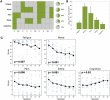Feasibility and tolerability of dual-target repetitive transcranial magnetic stimulation (rTMS) for treatment of myalgic encephalomyelitis/chronic fatigue syndrome (ME/CFS): An open label pilot study
Juliana Corlier, Hrag Peltekian, Thomas E. Valles, Cole D. Matthews, Doan Ngo, Reza Tadayonnejad, Evan H. Einstein, Scott A. Wilke, Aaron Slan, Margaret G. Distler, Gil Hoftman, Adesewa E. Adelekun, Hanadi A. Oughli, Michael K. Leuchter, Hewa Artin, Ralph J. Koek, Nathaniel D. Ginder, David E. Krantz, Thomas Strouse, Andrew F. Leuchter
[Line breaks added]
Objective
Myalgic Encephalomyelitis/Chronic Fatigue Syndrome (ME/CFS) is characterized by extreme, persistent fatigue, pain, sleep disturbances, cognitive dysfunction, and mood dysregulation. Repetitive Transcranial Magnetic Stimulation (rTMS) has shown efficacy for improving these symptoms in patients with depression, fibromyalgia, and other conditions.
The goal of this pilot study was to evaluate whether a novel protocol involving dual-target rTMS to the left dorsolateral prefrontal cortex (DLPFC) and the primary motor cortex (M1) would demonstrate benefit in ME/CFS patients.
Methods
Fifteen female participants with ME/CFS were enrolled to receive 30 rTMS sessions administered sequentially to left DLPFC and M1. Electroencephalograms (EEG) were recorded to explore whether there were baseline EEG characteristics indicative of outcome.
The primary outcome measure was percent change in five symptom domains (fatigue, pain, mood, sleep, and cognition) from baseline to the end of treatment.
Results
No serious adverse effects were observed. The initial five subjects dropped out due to poor treatment tolerability, and the remaining 10 subjects completed a modified protocol adjusted to improve tolerability.
These 10 subjects completed all study procedures and demonstrated some improvement in all five symptom domains. EEG analysis showed that lower delta and theta, and higher alpha oscillatory power at baseline, were associated with better final outcomes in fatigue and sleep.
Conclusions
Dual-target rTMS at 80–100 % of resting motor threshold (MT) appears to be safe and tolerable, with short-term efficacy for treatment of primary ME/CFS symptoms. These findings support larger controlled studies of this treatment approach for ME/CFS.
Web | PDF | Transcranial Magnetic Stimulation
Juliana Corlier, Hrag Peltekian, Thomas E. Valles, Cole D. Matthews, Doan Ngo, Reza Tadayonnejad, Evan H. Einstein, Scott A. Wilke, Aaron Slan, Margaret G. Distler, Gil Hoftman, Adesewa E. Adelekun, Hanadi A. Oughli, Michael K. Leuchter, Hewa Artin, Ralph J. Koek, Nathaniel D. Ginder, David E. Krantz, Thomas Strouse, Andrew F. Leuchter
[Line breaks added]
Objective
Myalgic Encephalomyelitis/Chronic Fatigue Syndrome (ME/CFS) is characterized by extreme, persistent fatigue, pain, sleep disturbances, cognitive dysfunction, and mood dysregulation. Repetitive Transcranial Magnetic Stimulation (rTMS) has shown efficacy for improving these symptoms in patients with depression, fibromyalgia, and other conditions.
The goal of this pilot study was to evaluate whether a novel protocol involving dual-target rTMS to the left dorsolateral prefrontal cortex (DLPFC) and the primary motor cortex (M1) would demonstrate benefit in ME/CFS patients.
Methods
Fifteen female participants with ME/CFS were enrolled to receive 30 rTMS sessions administered sequentially to left DLPFC and M1. Electroencephalograms (EEG) were recorded to explore whether there were baseline EEG characteristics indicative of outcome.
The primary outcome measure was percent change in five symptom domains (fatigue, pain, mood, sleep, and cognition) from baseline to the end of treatment.
Results
No serious adverse effects were observed. The initial five subjects dropped out due to poor treatment tolerability, and the remaining 10 subjects completed a modified protocol adjusted to improve tolerability.
These 10 subjects completed all study procedures and demonstrated some improvement in all five symptom domains. EEG analysis showed that lower delta and theta, and higher alpha oscillatory power at baseline, were associated with better final outcomes in fatigue and sleep.
Conclusions
Dual-target rTMS at 80–100 % of resting motor threshold (MT) appears to be safe and tolerable, with short-term efficacy for treatment of primary ME/CFS symptoms. These findings support larger controlled studies of this treatment approach for ME/CFS.
Web | PDF | Transcranial Magnetic Stimulation

